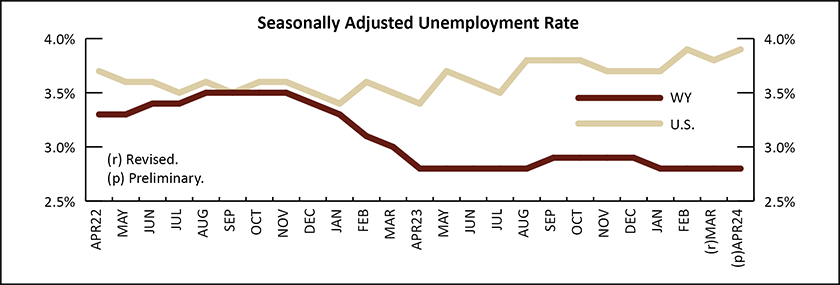Wyoming Labor Force Trends
June 2024 | Volume 61, No. 6
Click Here for PDF
Return to Table of Contents
Wyoming Unemployment Low and Stable at 2.8% in April 2024
by: David Bullard, Senior Economist
The Research & Planning section of the Wyoming Department of Workforce Services reported that the state’s seasonally adjusted1 unemployment rate remained unchanged from March to April at 2.8%. Wyoming’s unemployment rate also held steady from its year-ago level of 2.8%. In contrast, the U.S. unemployment rate edged upward from March to April, rising from 3.8% to 3.9% and was higher than its April 2023 level of 3.4%.
From March to April, most county unemployment rates followed their normal seasonal pattern and decreased. Warmer weather often brings seasonal job gains in construction, professional & business services, retail trade, and other sectors. The largest unemployment rate decreases occurred in Big Horn (down from 4.4% to 3.4%), Park (down from 3.8% to 2.9%), Washakie (down from 4.0% to 3.2%), Sweetwater (down from 3.8% to 3.0%), and Carbon (down from 3.6% to 2.8%) counties. Teton County’s unemployment rate rose from 2.1% in March to 2.6% in April as the end of the ski season gave rise to seasonal job losses.
From April 2023 to April 2024, jobless rates fell in 14 counties, rose slightly in six counties, and remained unchanged in three counties. The largest decreases were found in Teton (down from 3.5% to 2.6%) and Platte (down from 3.0% to 2.4%) counties. Uinta County’s unemployment rate increased from 3.1% to 3.4%.
In April, the lowest unemployment rates were reported in Weston County at 2.0%, Converse County at 2.2%, and Niobrara and Crook counties, each at 2.3%. Sublette County had the highest unemployment rate in the state at 3.6%. It was followed by Big Horn County and Uinta County, each at 3.4%.
Current Employment Statistics (CES) estimates show that total nonfarm employment in Wyoming (not seasonally adjusted and measured by place of work) rose from 285,200 in April 2023 to 290,100 in April 2024, an increase of 4,900 jobs (1.7%).
R&P's most recent monthly news release is available at https://doe.state.wy.us/LMI/news.htm.



 Hire Wyo
Hire Wyo